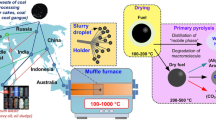Abstract
Fluid catalytic cracking of heavy ends to high-value liquid fuels is a common unit operation in oil refineries. In this process, the heavy feedstock that contains sulfur is cracked to light products. Sulphur content is hence redistributed in the liquid and gaseous products and coke of the catalyst used in this process. The coke is later burnt in the regenerator releasing sulfur into the discharged flue gas as SO2. In the present work, comprehensive emission inventories for a fluid catalytic cracking unit in a typical oil refinery are prepared. These inventories are based on calculations that assume complete combustion of catalyst coke in the regenerator. Yearly, material balances for both SO2 and particulate matters emissions are carried out taking into account seasonal variations in the operation of the process unit. The results presented in this article reflect the variation of sulfur in feedstock originating from various units in the refinery. The refinery operations are not dependant on seasons but controlled by market-driven conditions to maximize the profit. The seasonal impact on refinery emissions is minimal due to its operation at optimum capacity fulfilling the international market demand. The data presented and analyzed here can be used to assess the hazardous impact of SO2 and particulate matter emissions on surrounding areas of the refinery.











Similar content being viewed by others
Abbreviations
- F :
-
feed (T/h)
- L :
-
total liquid products (T/h)
- G :
-
total gas products (T/h)
- E :
-
total emission (T/h)
- A :
-
total air feed (T/h)
- M :
-
fresh catalyst (T/h)
- L 2 :
-
is heavy cycle oil
- x F1 :
-
sulfur weight fraction in liquid feed
- x j1 :
-
sulfur weight fraction in liquid products
- x j2 :
-
PM weight fraction in HCO
- y j1 :
-
sulfur weight fraction in gaseous products
- y E1 :
-
sulfur weight fraction in flue gases
- y E2 :
-
PM weight fraction in flue gases
References
Akeredolu, F. (1989). Atmospheric environment problems in Nigeria—an overview. Atmospheric Enubonmmt, 23(4), 783–792.
Mitchell, M. M., Jr., Hoffman, J. F., & Moore, H. F. (1993). Residual feed cracking catalyst. In J. S. Magee & J. M. M. Mitchell (Eds.), Fluid catalytic cracking: science and technology, studies in surface science and catalysis (Vol. 76, pp. 293–338). New York: Elsevier.
Whitcombe, J. M., Agranovski, I. E., & Braddock, R. D. (2003). Attrition due to mixing of hot and cold FCC catalyst particles. Powder Technology, 137, 120–130.
Venuto, P. B., & Habib, E. T. (1978). Catalyst-feedstock-engineering interactions in fluid catalytic cracking. Catalysis Reviews, Science and Engineering, 18, 1–150.
Maya-Yescasa, R., Villafuerte-Macıas, E. F., Aguilarb, R., & Salazar-Sotelod, D. (2004). Sulphur oxides emission during fluidized-bed catalytic cracking. Chemical Engineering Journal, 106, 145–152.
Chen, Y.-M. (2006). Recent advances in FCC technology. Powder Technology, 163, 2–8.
Author information
Authors and Affiliations
Corresponding author
Rights and permissions
About this article
Cite this article
Yateem, W., Nassehi, V. & Khan, A.R. Inventories of SO2 and Particulate Matter Emissions from Fluid Catalytic Cracking Units in Petroleum Refineries. Water Air Soil Pollut 214, 287–295 (2011). https://doi.org/10.1007/s11270-010-0423-z
Received:
Accepted:
Published:
Issue Date:
DOI: https://doi.org/10.1007/s11270-010-0423-z




